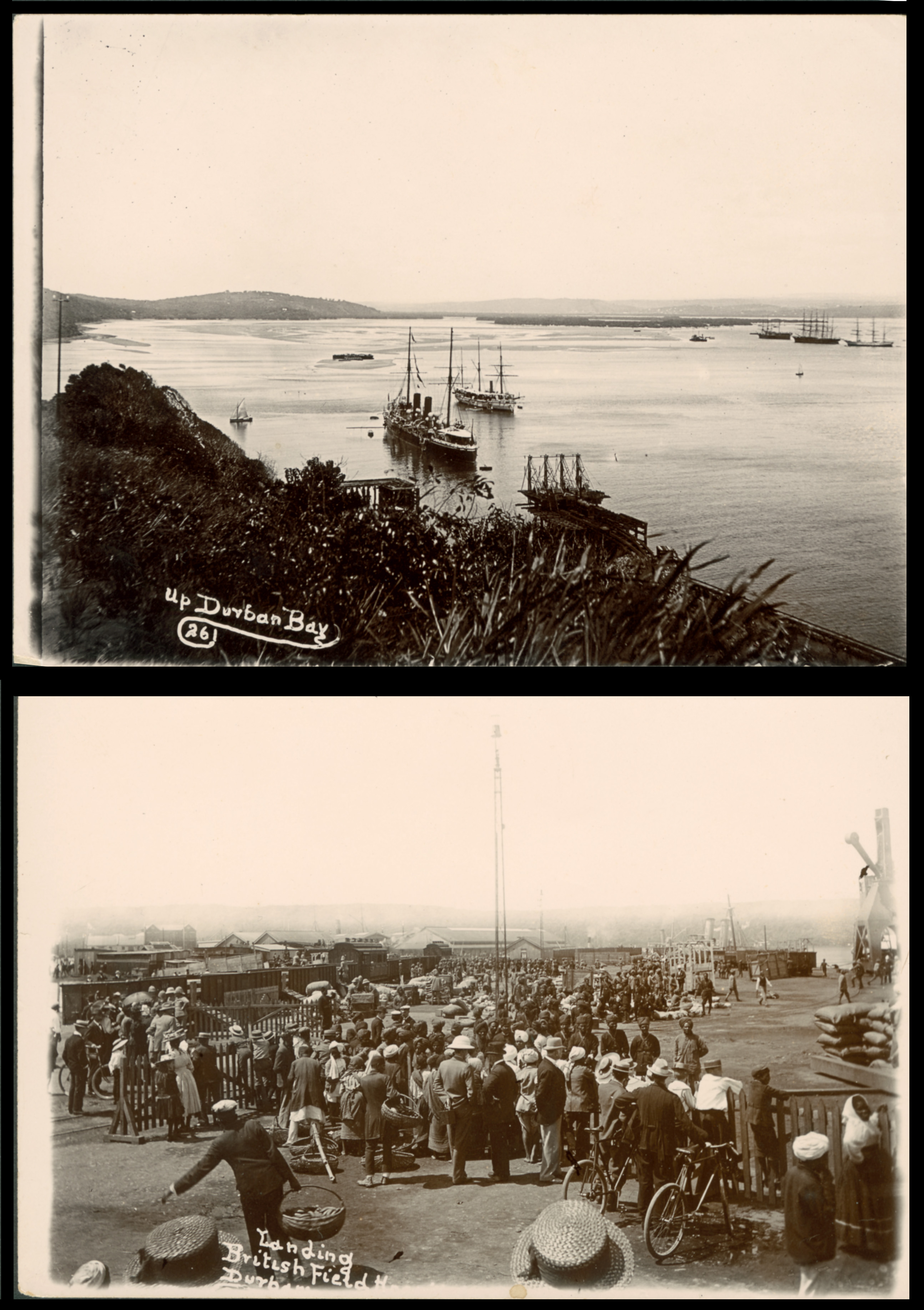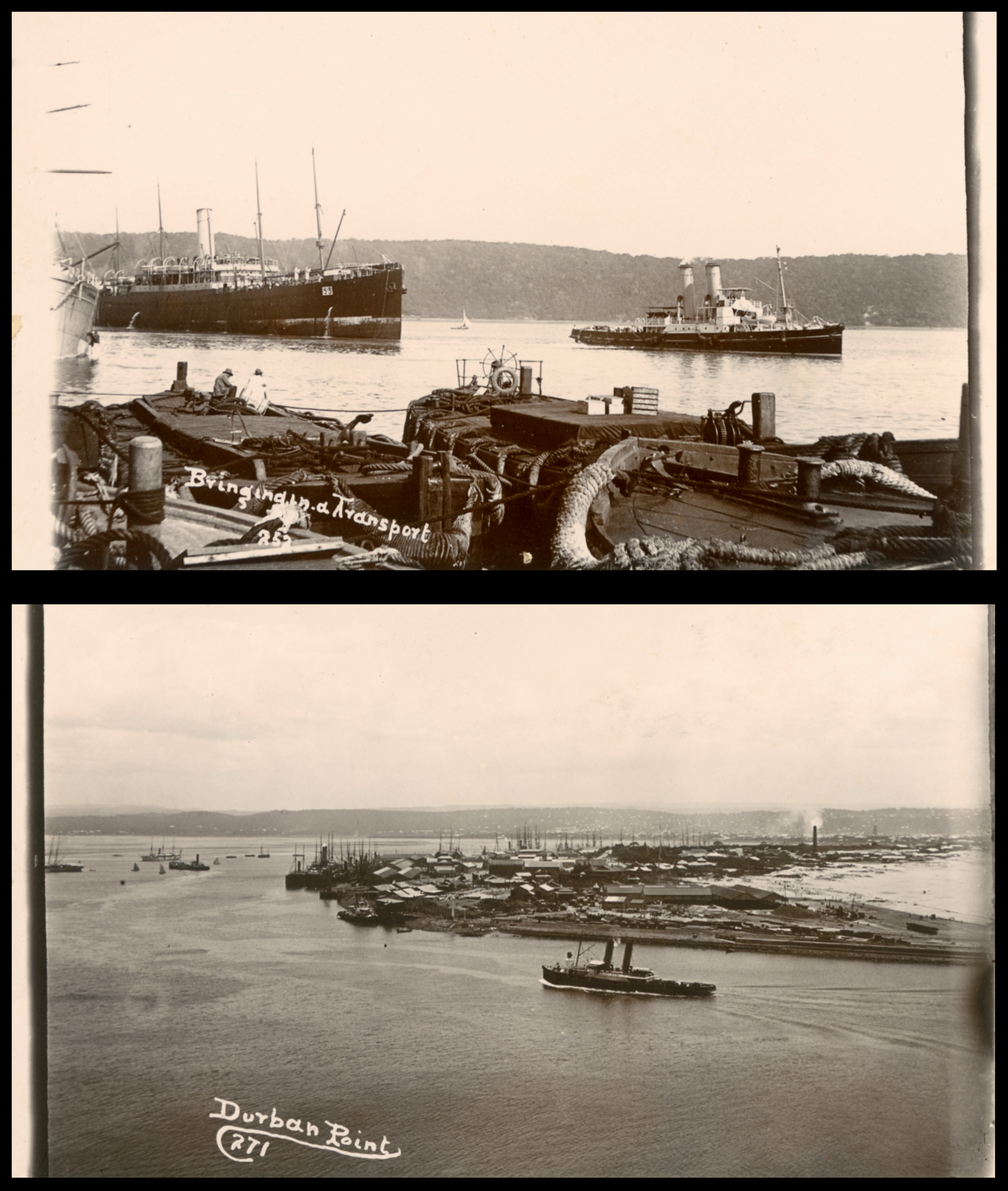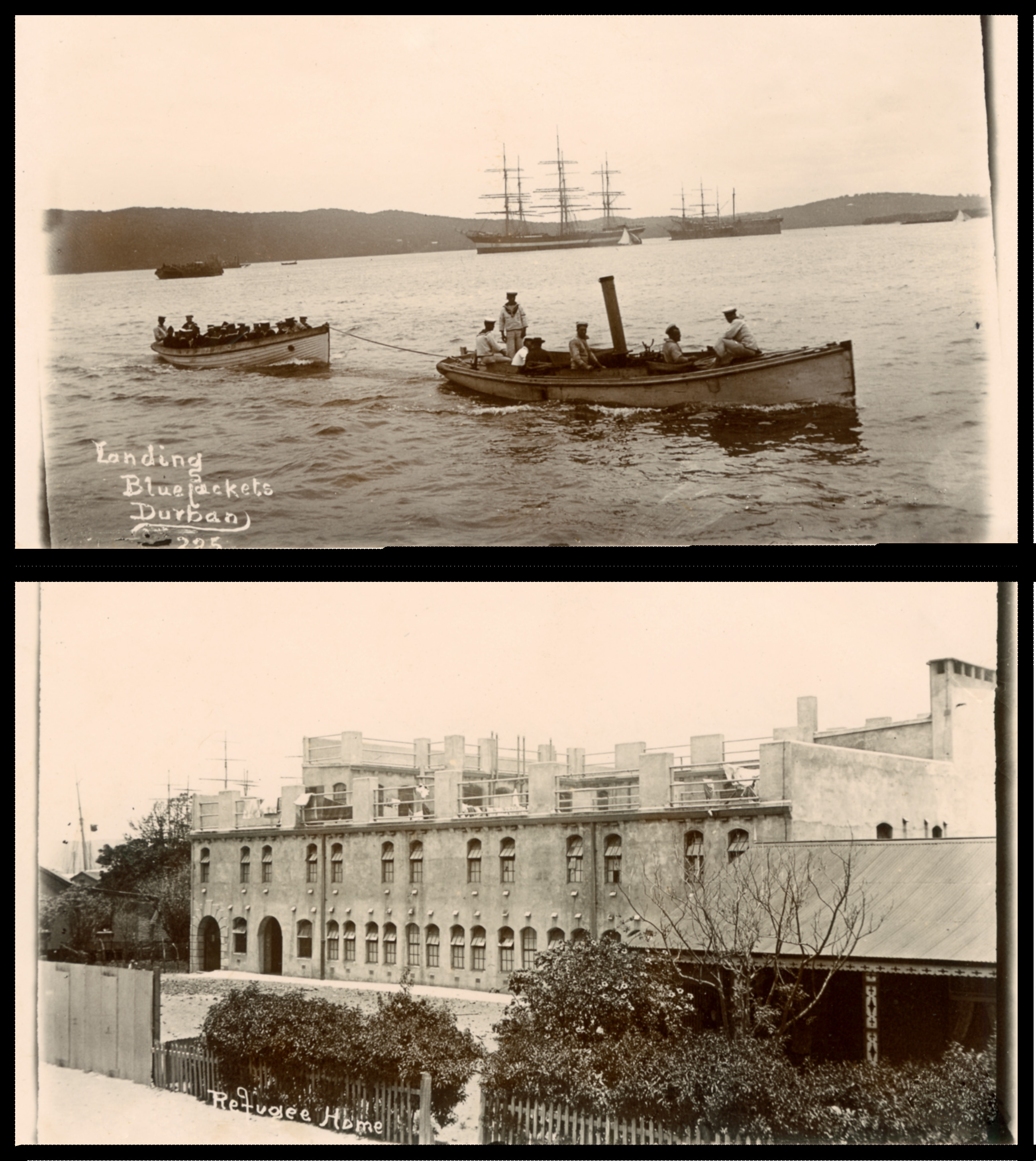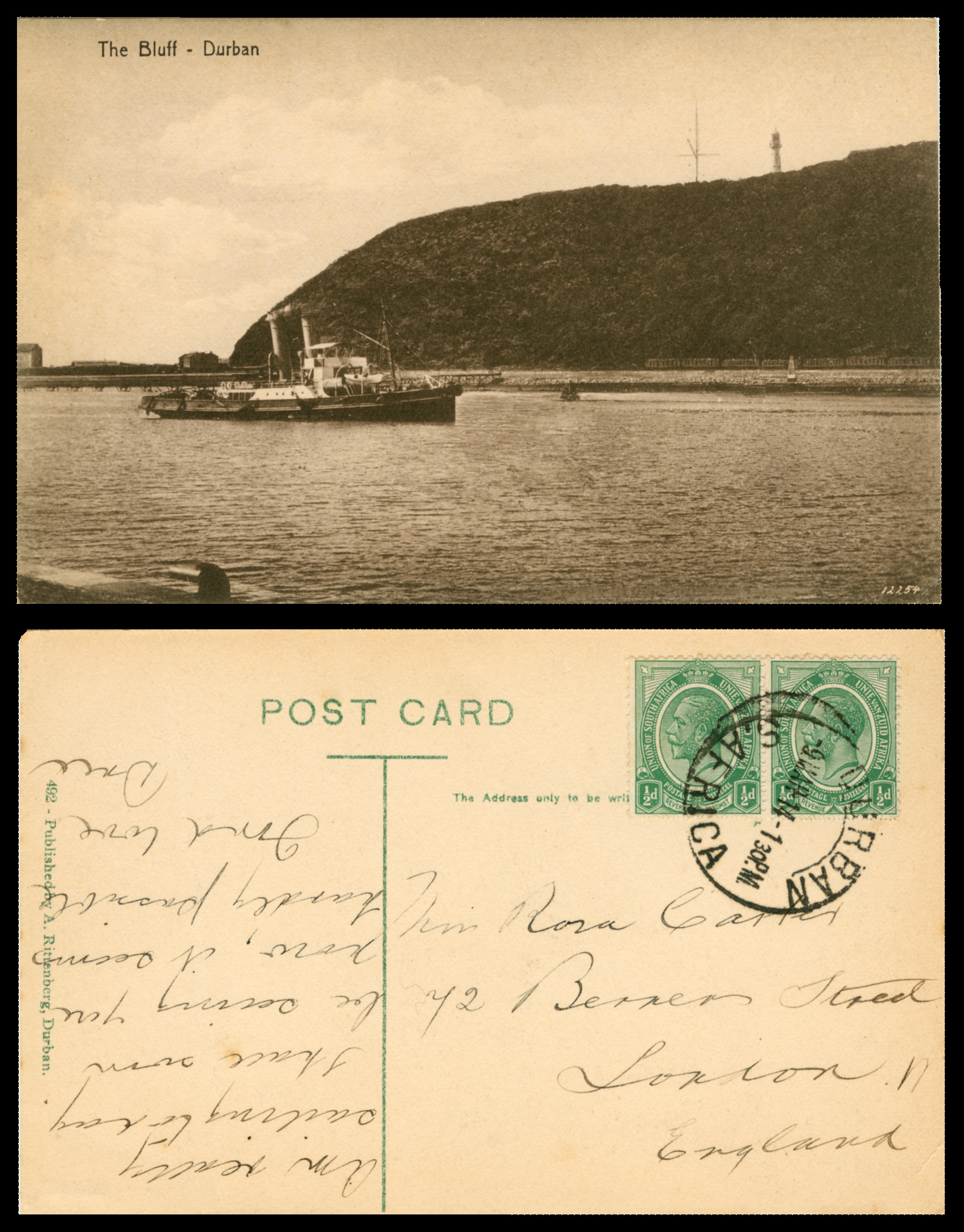The British Land in Durban 1899
Quote from Steve on January 30, 2023, 2:18 pmHere are a few random photos taken in Durban. I assume they are from 1899 and 1900. Any advice is welcomed.
1]. 'Up Durban Bay 26'.
The first shows HMS Pelorus at anchor in Durban. She is the ship closest to the shore. This is an awkard, shortened view of her because you are seeing her from her stern. Relatively well-armed for her size with eight QF (quick-firing) 4 inch and eight QF 3 pounder (47-mm) guns, she was designed to be an overseas workhorse gunboat. Following the start of the South African War, Pelorus was sent to South Africa where she was active on coastal operations between 8th December 1899 and 26th June 1900. In all 229 men from Pelorus were entitled to the Queen's South Africa medal, of which 215 gained it without clasp. (Clasps were awarded for land battles or campaigns. Serving at sea the Pelorus crew did not qualify.) In 1906, Pelorus was assigned to the Cape of Good Hope Station. Her most notable achievement was sailing 2,000 miles up the Amazon to the foothills of Peru.2]. 'Landing British Field Ho..... Durban'.
I am guessing that this is a Field Hospital coming ashore. It appears to be being loaded onto the train. There are a large number of Black people present. Perhaps they fear the Boer boast that they will soon be eating bananas on Durban Beach? Perhaps anticipating a growing demand, one hawker carries a basket of bananas, no doubt hoping to find a willing market among the newly arrived troops. Black policemen appear to be holding the largely White onlookers back. There are a number of turbanned people in the crowd, including a hawker wearing what I have heard Moslems in Cape Town refer to as a kufiya, a skull cap, but which Wikipedia tells me is a scarf. Being 1899, most Europeans, some with bicycles, are wearing lightweight straw 'boaters' but a small number of more monied-looking gentlemen are wearing a variety of distinguished headgear. It the background troops have formed up. An interesting photo but too small.3]. 'Bringing in a Transport'.
The caption on the reverse of the photo says 'Boer War. Transport No. 53. Montfort'. I guess the ship is the Montfort. The number '53' can be clearly seen on the ship's forward starboard hull. The Montfort was commissioned in 1899 as a cargo ship. We see here a spanking new ship. She is not a troop transport. She is probably bringing munitions. She was transporting 'general goods' from Canada to GB during WW1 when she was torpedoed and sunk off Cornwall in 1918 with the loss of five lives. (No. 53 was Ismore which ran aground and was wrecked en route to the Cape. Normally officers of wartime ships receive Transport Medals. The Ismore's officers received none!)Of greater interest to me is the tug. I wonder if this is Durban's Sir John Robinson, named after the colony's first Prime Minister, and popularly known as the 'Sir John'. (It may also be the Sir David Hunter which also had twin funnels.) The Sir John was seconded for WW1 service during the invasion of GSWA in 1915 where the Durban Light Infantry Historian, Arthur Clive Martin (1892-1985), was surprised to see it at work in Walfisch Bay on his arrival there. Another serviceman, Signaller Andrew Proctor, records in his diary that he was taken off the Galway Castle in Walfisch Bay and transported to Swakopmund "in a nasty swell' by the tug 'Sir John' on Sunday 24th January 1915.
4]. Durban Point
Being a Capey, not a Banana Boy, I am unfamiliar with Durban, never having spent a night there. I presume this photo was taken from a highpoint on the Bluff looking down towards the harbour.5]. Landing Bluejackets Durban 225
Royal Navy sailors coming ashore towed by a presumably steam-powered cutter. What surprises me in these images of Durban and also Simonstown at this time is the many sailing boats still apparently working in the great age of coal and steam.6]. Refugee Home
The war disrupted the lives of many people of all races. There were two main periods of disruption, the first being the exodus from the ZAR before the start of the inevitable war. These were 'Uitlanders' or foreigners trying to get away for a variety of reasons, the most important being to avoide service on the 'wrong side' or being jailed for refusing to do so. Most headed for the coast ie, Durban. The second phase was the ruthless British response to the guerilla war phase of the conflict. This resulted in the deaths of some 26,000 Boer women, old men but mostly children in so-called 'refugee camps'. Some 16,000 Black people also died in these refugee camps. In the initial stage of the Boer invasion of Natal in late 1899, thousands of civilians fled the fighting. I imagine, but do not know for certain, that this photo of the 'Refugee House' is from this earlier stage of the war, perhaps accomodating either Natal and or Uitlander refugees. The caption of the reverse reveals a little of Natal's British anti-Asian bigotry. It says "African Boating Company Coolie Barracks where refugee women and children are housed". Gandhi would have something to say! So do I!
Here are a few random photos taken in Durban. I assume they are from 1899 and 1900. Any advice is welcomed.
1]. 'Up Durban Bay 26'.
The first shows HMS Pelorus at anchor in Durban. She is the ship closest to the shore. This is an awkard, shortened view of her because you are seeing her from her stern. Relatively well-armed for her size with eight QF (quick-firing) 4 inch and eight QF 3 pounder (47-mm) guns, she was designed to be an overseas workhorse gunboat. Following the start of the South African War, Pelorus was sent to South Africa where she was active on coastal operations between 8th December 1899 and 26th June 1900. In all 229 men from Pelorus were entitled to the Queen's South Africa medal, of which 215 gained it without clasp. (Clasps were awarded for land battles or campaigns. Serving at sea the Pelorus crew did not qualify.) In 1906, Pelorus was assigned to the Cape of Good Hope Station. Her most notable achievement was sailing 2,000 miles up the Amazon to the foothills of Peru.
2]. 'Landing British Field Ho..... Durban'.
I am guessing that this is a Field Hospital coming ashore. It appears to be being loaded onto the train. There are a large number of Black people present. Perhaps they fear the Boer boast that they will soon be eating bananas on Durban Beach? Perhaps anticipating a growing demand, one hawker carries a basket of bananas, no doubt hoping to find a willing market among the newly arrived troops. Black policemen appear to be holding the largely White onlookers back. There are a number of turbanned people in the crowd, including a hawker wearing what I have heard Moslems in Cape Town refer to as a kufiya, a skull cap, but which Wikipedia tells me is a scarf. Being 1899, most Europeans, some with bicycles, are wearing lightweight straw 'boaters' but a small number of more monied-looking gentlemen are wearing a variety of distinguished headgear. It the background troops have formed up. An interesting photo but too small.
3]. 'Bringing in a Transport'.
The caption on the reverse of the photo says 'Boer War. Transport No. 53. Montfort'. I guess the ship is the Montfort. The number '53' can be clearly seen on the ship's forward starboard hull. The Montfort was commissioned in 1899 as a cargo ship. We see here a spanking new ship. She is not a troop transport. She is probably bringing munitions. She was transporting 'general goods' from Canada to GB during WW1 when she was torpedoed and sunk off Cornwall in 1918 with the loss of five lives. (No. 53 was Ismore which ran aground and was wrecked en route to the Cape. Normally officers of wartime ships receive Transport Medals. The Ismore's officers received none!)
Of greater interest to me is the tug. I wonder if this is Durban's Sir John Robinson, named after the colony's first Prime Minister, and popularly known as the 'Sir John'. (It may also be the Sir David Hunter which also had twin funnels.) The Sir John was seconded for WW1 service during the invasion of GSWA in 1915 where the Durban Light Infantry Historian, Arthur Clive Martin (1892-1985), was surprised to see it at work in Walfisch Bay on his arrival there. Another serviceman, Signaller Andrew Proctor, records in his diary that he was taken off the Galway Castle in Walfisch Bay and transported to Swakopmund "in a nasty swell' by the tug 'Sir John' on Sunday 24th January 1915.
4]. Durban Point
Being a Capey, not a Banana Boy, I am unfamiliar with Durban, never having spent a night there. I presume this photo was taken from a highpoint on the Bluff looking down towards the harbour.
5]. Landing Bluejackets Durban 225
Royal Navy sailors coming ashore towed by a presumably steam-powered cutter. What surprises me in these images of Durban and also Simonstown at this time is the many sailing boats still apparently working in the great age of coal and steam.
6]. Refugee Home
The war disrupted the lives of many people of all races. There were two main periods of disruption, the first being the exodus from the ZAR before the start of the inevitable war. These were 'Uitlanders' or foreigners trying to get away for a variety of reasons, the most important being to avoide service on the 'wrong side' or being jailed for refusing to do so. Most headed for the coast ie, Durban. The second phase was the ruthless British response to the guerilla war phase of the conflict. This resulted in the deaths of some 26,000 Boer women, old men but mostly children in so-called 'refugee camps'. Some 16,000 Black people also died in these refugee camps. In the initial stage of the Boer invasion of Natal in late 1899, thousands of civilians fled the fighting. I imagine, but do not know for certain, that this photo of the 'Refugee House' is from this earlier stage of the war, perhaps accomodating either Natal and or Uitlander refugees. The caption of the reverse reveals a little of Natal's British anti-Asian bigotry. It says "African Boating Company Coolie Barracks where refugee women and children are housed". Gandhi would have something to say! So do I!
Uploaded files:
Quote from Steve on February 8, 2023, 11:59 amHere is a rather dull postcard of a Durban tug, probably the 'Sir John Robinson', built 1897, with the Bluff in the background. It would appear to be the same vessel as the one shown 3. above, albeit with some minor super-structural changes made during fifteen years of intervening service. The postcard was posted in Durban on '9 MAR 14'. World War 1 would start on the 8th July 1914, four months later. By the start of 1915, the Sir John would in Walvis Bay aiding the Empire's German South West Africa invasion. Thus, this tug has the distinction of assisting in the landing of two military campaign forces in southern Africa, the SAW (1899-1902) and GSWA (1914-1915). She worked into the 1930s but was a wreck by the start of WW2 and so missed her third big show.
Here is a rather dull postcard of a Durban tug, probably the 'Sir John Robinson', built 1897, with the Bluff in the background. It would appear to be the same vessel as the one shown 3. above, albeit with some minor super-structural changes made during fifteen years of intervening service. The postcard was posted in Durban on '9 MAR 14'. World War 1 would start on the 8th July 1914, four months later. By the start of 1915, the Sir John would in Walvis Bay aiding the Empire's German South West Africa invasion. Thus, this tug has the distinction of assisting in the landing of two military campaign forces in southern Africa, the SAW (1899-1902) and GSWA (1914-1915). She worked into the 1930s but was a wreck by the start of WW2 and so missed her third big show.
Uploaded files:



